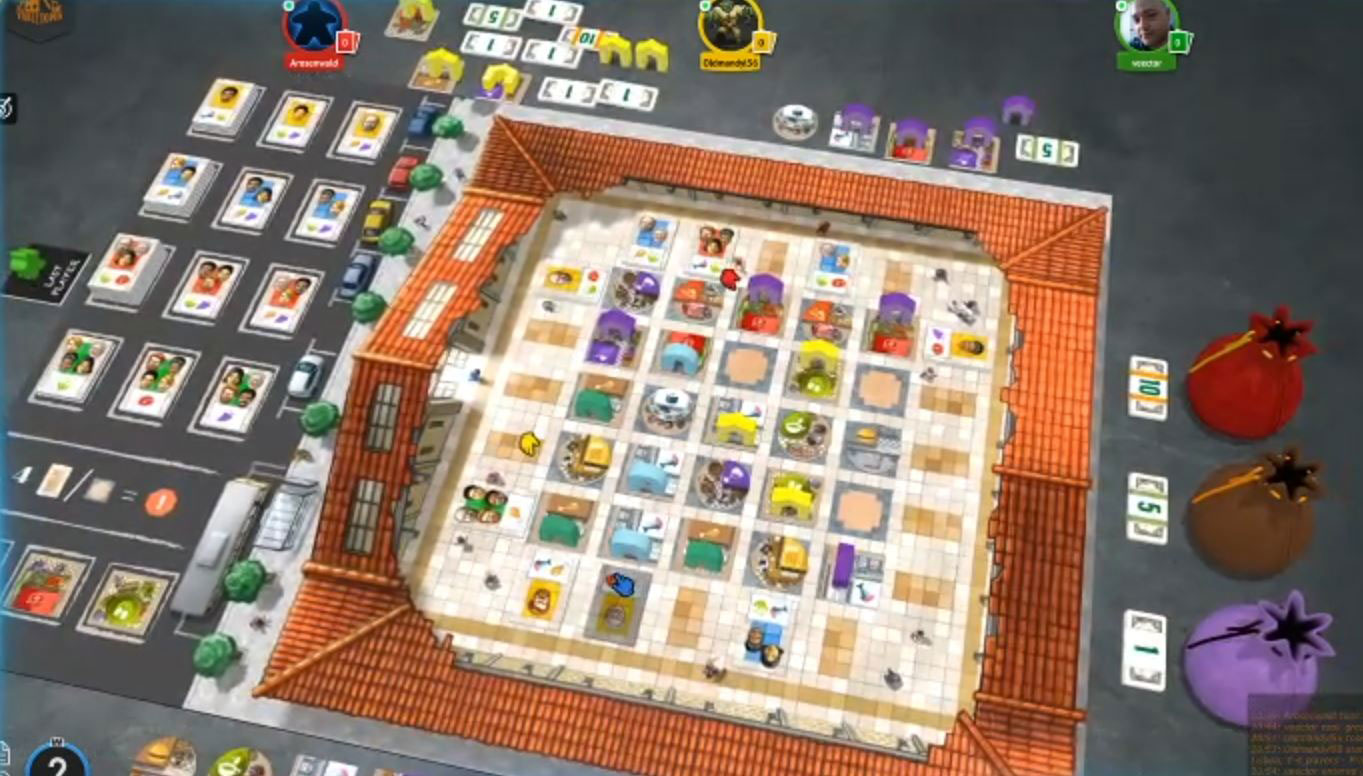Note: This preview uses pre-release components and rules. What you see here may be different from the final, published game.
 Vital Lacerda is one of the most well-known designers of heavy games in our hobby. His complex eurogames such as Lisboa, Vinhos, and On Mars are not only praised by gamers, but also see a large number of backers pledge toward the Kickstarter projects run by publisher Eagle-Gryphon Games. Currently on Kickstarter, we have a different type of game from Lacerda (and co-designer Julián Pombo). This title called Mercado de Lisboa, is a thinky-filler using the city-building system used in Lisboa (hence the name). Games take around 30 minutes and plays 1-4 players.
Vital Lacerda is one of the most well-known designers of heavy games in our hobby. His complex eurogames such as Lisboa, Vinhos, and On Mars are not only praised by gamers, but also see a large number of backers pledge toward the Kickstarter projects run by publisher Eagle-Gryphon Games. Currently on Kickstarter, we have a different type of game from Lacerda (and co-designer Julián Pombo). This title called Mercado de Lisboa, is a thinky-filler using the city-building system used in Lisboa (hence the name). Games take around 30 minutes and plays 1-4 players.
Gameplay Overview:
Mercado de Lisboa sees players placing their own market stands out in a 5×5 grid. Those stands come in five types: grapes, meat, tomatoes, flowers, and fish. The players begin with three of those market stands off the board in front of them with their own wooden stands placed on top of the tiles to show ownership. There are also round tiles situated about the board called restaurants. They come in six varieties, five which match the market stands and one that is wild and can pair with any of the market stands. They begin on a grey side, but when anything is placed on the grey restaurant, that player claims the tile, places it with their unused market tiles while flipping it to the side with color to show ownership.
On a turn, a player can take one of four actions. The simplest is to take one dollar from the bank. If that action is taken by all the players consecutively, the game ends immediately to prevent a stalemate. The second action is to place a market tile. When placed, the active player must pay equal to the number of stands in either the row or column, counting itself. The third action is to place a restaurant. When placed, they award a dollar to the active player.

The final action is to place customers, which is the way to get a large payout. Customers are looking for goods, labeled on the bottom of the tile, and come in four different tiers that are differentiated by the number of faces on each tile. When placing a customer they must go in a row or column where the active player has a market stand matching one or both of the customer’s demands.
After placing the customer, the stands that match their demands pays the number of stands times the number of customers on the tile. This is an equation that each player with do individually. But this is where restaurant tiles impact the game. If a market stand is orthogonally adjacent to an active restaurant of the same color (or a pub) then the value of the stand goes up by one. This means a stand with four active restaurants that would adjust the value would be worth five when calculating the payout.
The game ends when there are only four remaining spaces on the grid or four remaining places for customers to be placed. Each unplayed restaurant a player holds costs one dollar, and whoever has the most money is the winner.

Game Impressions:
Mercado de Lisboa is a game where the more experienced player is regularly going to win, but that shouldn’t come as a surprise when considering it’s a game from Vital Lacerda. Just because the rules are condense doesn’t mean the decisions are light.
Similar to cube rail games, players should be paying attention to what the other players are working towards, as well as the initial draws of markets and restaurants. The board is seeded with 11 restaurants that will be claimed by players throughout the game, and those grabbed up will be used to help restaurants. Once they’re placed, they can be used to capitalize on customers placed. Once a customer is placed, then a stand can be placed that cuts the cost off the top, and then the stand can be used in future rounds with the higher-value customers.

Turns can be a mix of quick to finish and prone to analysis paralysis. Placing a restaurant and taking a dollar seem fairly basic. Many times they are the necessary actions to do when short on money. But when placing a stand or customer, those must be thought out. Each option is considered, particularly which customer will be used and where. Sometimes the customer choice is cut and dry because there is only one possible based on the number of stands in the rows and columns and demands that you can meet. Other times, there are a variety of options that are useful, either to net the largest payout or to place a customer with a lower payout that opponents have access to.
Who Is This Game For?
Mercado de Lisboa is marketed as a thinky filler, and in that regard, I think it fits the bill. Decisions can be tough, especially in a game that finishes in 30 minutes (all of my plays have been at that playtime).

But like most fillers, the depth is not to the degree a longer game can provide. Yes, there are exceptions to the rule, but Mercado de Lisboa is more of a reactive game as opposed to a long-term strategic game. When taking a look at which customer tile to place, the options may be suboptimal based on luck of the draw. Same goes for the market tile a player takes when replenishing back up to three. Sometimes the display doesn’t have what a player wants, so they take a stand they may never do anything with.
At the same time, early decisions can affect what happens in the end game, and that first market stand can be a commitment to your strategy. The mix of luck and weight on early-turn decisions can be a tad off putting, particularly with no way to mitigate that luck of the draw.
Final Thoughts:
Let me be clear: this is a solid game. The rules are simple to teach and the four actions are quick to do. My difficulty is that I’m unsure where I stand on it in the economic category of games. Mercado de Lisboa doesn’t feel like an economic-focused game, even though money is both the thing you’re spending and victory points. In many ways, I would say it feels more like a eurogame that happens to fit into the economic category just on a smaller scale. So depending on what form of economics you find amusement in, that may impact your decision in backing.
But in reality, this gives more to chew on than the average 30 minute game, particularly for the price ($34 before shipping). And even if you’re on the fence and would like to try before you buy, it is available to play on Tabletopia (which is where you see screenshots from). Mercado de Lisboa is on Kickstarter until September 18.
As always, we don’t post ratings for preview copies as the components and rules may change from the final game. Check back with us after the game is produced for a full review.






















